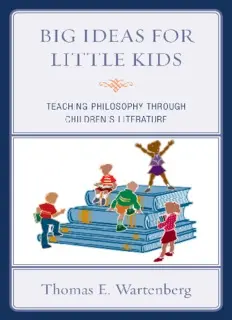
Big Ideas for Little Kids: Teaching Philosophy through Children's PDF
Preview Big Ideas for Little Kids: Teaching Philosophy through Children's
B I G I D E A S F O R L I T T L E K I D S Teaching Philosophy through Children’s Literature Thomas E. Wartenberg Rowman & Littlefield Education A Division of Rowman & Littlefield Publishers, Inc. Lanham (cid:129) New York (cid:129) Toronto (cid:129) Plymouth, UK Published by Rowman & Littlefield Education A division of Rowman & Littlefield Publishers, Inc. A wholly owned subsidiary of The Rowman & Littlefield Publishing Group, Inc. 4501 Forbes Boulevard, Suite 200, Lanham, Maryland 20706 http://www.rowmaneducation.com Estover Road, Plymouth PL6 7PY, United Kingdom Copyright © 2009 by Thomas E. Wartenberg All rights reserved. No part of this book may be reproduced in any form or by any electronic or mechanical means, including information storage and retrieval systems, without written permission from the publisher, except by a reviewer who may quote passages in a review. British Library Cataloguing in Publication Information Available Library of Congress Cataloging-in-Publication Data Wartenberg, Thomas E. Big ideas for little kids : teaching philosophy through children’s literature / Thomas E. Wartenberg. p. cm. Includes bibliographical references (p. ). ISBN 978-1-60709-334-3 (cloth : alk. paper) — ISBN 978-1-60709-335-0 (pbk. : alk. paper) — ISBN 978-1-60709-336-7 (ebook) 1. Philosophy—Study and teaching (Elementary) 2. Children’s literature— Study and teaching (Elementary) 3. Interdisciplinary approach in education. I. Title. B52.W378 2009 372.8--dc22 2009015581 (cid:2) ™ The paper used in this publication meets the minimum requirements of American National Standard for Information Sciences—Permanence of Paper for Printed Library Materials, ANSI/NISO Z39.48-1992. Printed in the United States of America For Jake, who first showed me what young children are capable of doing, and for Gary Matthews, who showed me what to do with that knowledge CONTENTS List of Tables vii Preface ix PART I T EACHING PHILOSOPHY IN ELEMENTARY SCHOOLS 1 Natural-Born Philosophers 3 2 How I Became a Children’s Philosophy Teacher 9 3 Learner-Centered Teaching 15 4 The “Game” of Philosophy 25 PART II PREPARING TO TEACH 5 The Elementary-School Introduction to Philosophy Course 37 6 Preparing a Lesson Plan 47 7 Leading a Philosophical Discussion 55 v vi CONTENTS PART III THE STORIES 8 “Dragons and Giants”: Teaching Ethics 63 9 Frederick: Teaching Social and Political Philosophy 73 10 The Important Book: Teaching Metaphysics 81 11 The Wonderful Wizard of Oz: Teaching the Philosophy of Mind 89 12 The Giving Tree: Teaching Environmental Philosophy 95 13 Morris the Moose: Teaching Epistemology 103 14 Knuffle Bunny: Teaching the Philosophy of Language 115 15 Emily’s Art: Teaching Aesthetics 125 PART IV IMPLICATIONS 16 Suggested Follow-Up Activities after Philosophy Discussions 135 17 Conclusion 139 Appendix 143 References 149 LIST OF TABLES Table 3.1 Two Models of Learning 18 Table 4.1 Rules for Doing Philosophy 33 Table 5.1 The Basic Fields of Philosophy 38 Table 5.2 How We Do Philosophy! 41 Table 6.1 How Frog and Toad Try to Figure Out Whether They Are Brave 51 Table 7.1 The Six Pieces of Advice for Facilitators 60 Table 8.1 How Frog and Toad Try to Figure Out Whether They Are Brave 66 Table 9.1 A Comparison of What Frederick Does with What the Other Mice Do 76 Table 10.1 The Important Things about . . . 85 Table 11.1 How the Tin Woodman Differs from Normal Human Beings 92 Table 12.1 How the Boy Treats the Giving Tree 99 Table 13.1 Is the Cow a Moose? 107 Table 14.1 Is Trixie Really Talking? 119 Table 15.1 Comparing Emily’s Painting with Kelly’s 128 vii PREFACE T his book contains everything necessary for teaching an introduction to philosophy class in elementary schools. It is the result of my own ex- perience discussing philosophical issues with young children, from first to fifth graders, over the past twenty years. Since the very idea that kids are capable of taking part in a philosophical dialogue will surprise many of you, the book also explains quite carefully the rationale for discussing philosophy with them and, indeed, the importance of doing so. My goal in introducing philosophy to young children has always been to encourage and support elementary-school classroom teachers in their efforts to bring philosophy into their classrooms. Because my hope is that this book will spur the efforts of teachers to do so, I emphasize the fact that you do not have to have a background in philosophy to become an elementary-school philosophy teacher. All you need is a genuine inter- est in fostering the independence, creativity, and inquisitiveness of your students—as well as patience and a sense of humor! If you possess these and are interested in introducing philosophy into your elementary-school classroom, you’ll find everything you need to do so in this book. Although I began by working with teachers to help them introduce philosophy into their classrooms, for the past decade my primary in- volvement has been through a course that I teach at Mount Holyoke ix
